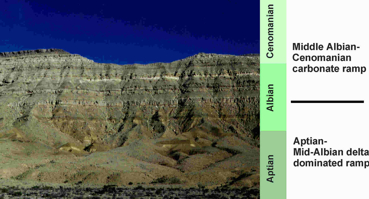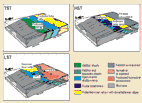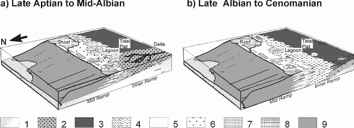The Aptian to Cenomanian Carbonate ramp of the Northern Sinai
Martina Bachmann and Jochen Kuss
The Mid-Cretaceous carbonate ramp of the northern Sinai developed in
two stages on a passive continental margin overlying basal rift suites.
The lower delta-dominated ramp (Late Aptian - Mid-Albian) in the north
evolved into the upper carbonate-dominated ramp (Late Albian - Cenomanian)
which covered the central and southeastern parts of the Sinai. The transition
between the two ramp settings took place during a period of a 2nd-order
sea-level rise and a major change in climatic conditions. The sedimentary
patterns are superimposed by higher-frequency relative sea-level changes.
The influence of the 3rd-order relative sea-level changes on the ramp
deposition was reconstructed on the basis of facies patterns, sedimentary
geometries, and the distribution of microfacies types. As regional tectonic
movements were of subordinate importance, a sequence stratigraphic interpretation
allows a fine-scale estimation of the changing ramp settings and their
characteristics (Bachmann & Kuss, 1998).
 Gebel Mansour section, northern Sinai, Maghara area. The section contains
two sedimentary units, the Late Aptian to Mid-Albian delta dominated sediments
and the Mid-Albian to Cenomanian carbonate ramp deposits.
Gebel Mansour section, northern Sinai, Maghara area. The section contains
two sedimentary units, the Late Aptian to Mid-Albian delta dominated sediments
and the Mid-Albian to Cenomanian carbonate ramp deposits.
The combined use of semiquantitative microfacies analysis and sequence
stratigraphy enables the study of the factors controlling deposition during
the different systems tracts, including the respective microfacies distributions.
They indicate that 3rd-order sea-level fluctuations result not only in
simple shifts of facies belts up and down the ramp but also in changing
environmental factors such as water circulation, carbonate production
and siliciclastic input (Bachmann & Kuss, 1998).
 Depositional models for the systems tracts of the Mid-Albian to Cenomanian
carbonate ramp. Most obvious differences concern the distribution of carbonate
shoals and biostromes within the individual systems tracts. Modified according:
Bachmann & Kuss (1998)
Depositional models for the systems tracts of the Mid-Albian to Cenomanian
carbonate ramp. Most obvious differences concern the distribution of carbonate
shoals and biostromes within the individual systems tracts. Modified according:
Bachmann & Kuss (1998)
In collaboration with some project partners, the detailed analysis of larger foraminifers, algae (Kuss), ostracods (Bassiouni) and rudists (Steuber) allows an exact age dating of the sequence boundaries. Additionally, a new depositional model will include the dependence of the distribution of these biota on sea-level changings.

